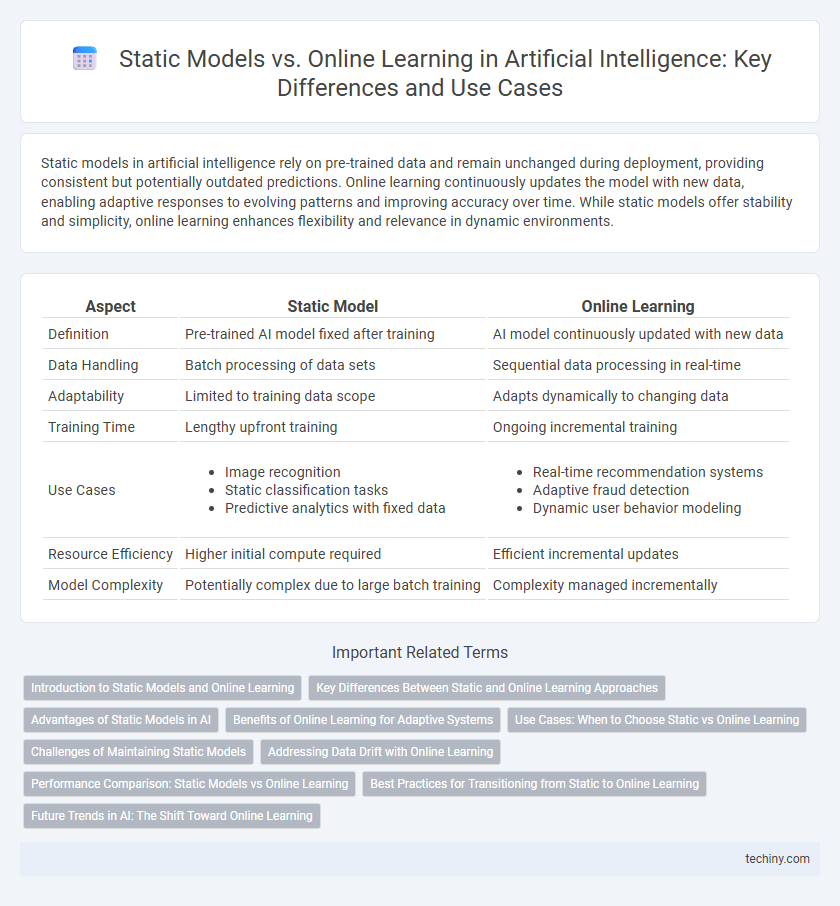Static models in artificial intelligence rely on pre-trained data and remain unchanged during deployment, providing consistent but potentially outdated predictions. Online learning continuously updates the model with new data, enabling adaptive responses to evolving patterns and improving accuracy over time. While static models offer stability and simplicity, online learning enhances flexibility and relevance in dynamic environments.
Table of Comparison
| Aspect | Static Model | Online Learning |
|---|---|---|
| Definition | Pre-trained AI model fixed after training | AI model continuously updated with new data |
| Data Handling | Batch processing of data sets | Sequential data processing in real-time |
| Adaptability | Limited to training data scope | Adapts dynamically to changing data |
| Training Time | Lengthy upfront training | Ongoing incremental training |
| Use Cases |
|
|
| Resource Efficiency | Higher initial compute required | Efficient incremental updates |
| Model Complexity | Potentially complex due to large batch training | Complexity managed incrementally |
Introduction to Static Models and Online Learning
Static models in artificial intelligence are trained on a fixed dataset and remain unchanged during deployment, ensuring consistent performance but limited adaptability. Online learning algorithms continuously update their parameters by incorporating new data in real-time, enhancing responsiveness to evolving patterns and environments. This distinction is crucial for applications requiring either stability or flexibility in dynamic data scenarios.
Key Differences Between Static and Online Learning Approaches
Static models rely on fixed training data, making them efficient for stable environments but less adaptable to new or evolving data patterns. Online learning continuously updates the model with incoming data, allowing real-time adaptation and improved performance in dynamic contexts. Key differences include data processing methods, adaptability, and computational requirements, with online learning offering greater flexibility at the cost of increased complexity.
Advantages of Static Models in AI
Static models in AI offer the advantage of consistent performance due to their fixed parameters, enabling reliable and predictable outcomes in controlled environments. These models require less computational resources during inference since they do not update in real-time, making them efficient for deployment in resource-constrained settings. Furthermore, static models simplify compliance and validation processes, as their behavior remains stable and easier to audit compared to dynamic online learning systems.
Benefits of Online Learning for Adaptive Systems
Online learning enables adaptive systems to continuously update their models with new data, ensuring real-time responsiveness and improved accuracy in dynamic environments. This approach reduces the need for retraining on entire datasets, saving computational resources and accelerating decision-making processes. Online learning enhances personalization and robustness in AI applications by allowing models to evolve alongside changing patterns and user behaviors.
Use Cases: When to Choose Static vs Online Learning
Static models are ideal for applications with stable data distributions and limited real-time input, such as image classification in medical diagnostics where consistent accuracy is crucial. Online learning excels in dynamic environments like fraud detection and personalized recommendation systems, where data continuously evolves and models must adapt quickly. Choosing between static and online learning depends on data volatility, computational resources, and the necessity for model adaptability in real-time scenarios.
Challenges of Maintaining Static Models
Static models in artificial intelligence face significant challenges due to their inability to adapt to new data, resulting in performance degradation over time as real-world conditions evolve. They require frequent retraining on updated datasets, which can be resource-intensive and time-consuming, hindering scalability in dynamic environments. Moreover, static models struggle with concept drift, where changes in data distributions negatively impact prediction accuracy, necessitating continuous monitoring and intervention.
Addressing Data Drift with Online Learning
Static models rely on fixed training data, making them vulnerable to performance degradation due to data drift in dynamic environments. Online learning continually updates the model with new data, enabling real-time adaptation to evolving patterns and maintaining accuracy. This adaptive capability is crucial for applications like fraud detection and recommendation systems where data distributions change rapidly.
Performance Comparison: Static Models vs Online Learning
Static models maintain consistent performance by relying on pre-trained data, but struggle to adapt to evolving patterns and novel inputs. Online learning continuously updates model parameters with new data, enabling higher accuracy and responsiveness in dynamic environments. Performance comparison reveals that online learning outperforms static models in real-time applications where data distributions shift frequently.
Best Practices for Transitioning from Static to Online Learning
Transitioning from static models to online learning requires continuous data integration and real-time model updates to enhance adaptability and performance. Implementing robust monitoring systems and adaptive algorithms ensures the model remains accurate as data distributions evolve. Emphasizing incremental learning techniques and scalable infrastructure supports efficient handling of streaming data while minimizing model degradation.
Future Trends in AI: The Shift Toward Online Learning
Static models, which rely on fixed datasets and pre-trained parameters, are increasingly being supplemented by online learning techniques that enable real-time adaptation to new data streams. Advances in AI architectures and edge computing facilitate continuous model updates, significantly improving performance in dynamic environments such as autonomous systems and personalized recommendations. Future trends indicate a growing emphasis on hybrid frameworks that integrate static pre-training with online learning for robust, scalable, and context-aware intelligence.
Static Model vs Online Learning Infographic

 techiny.com
techiny.com